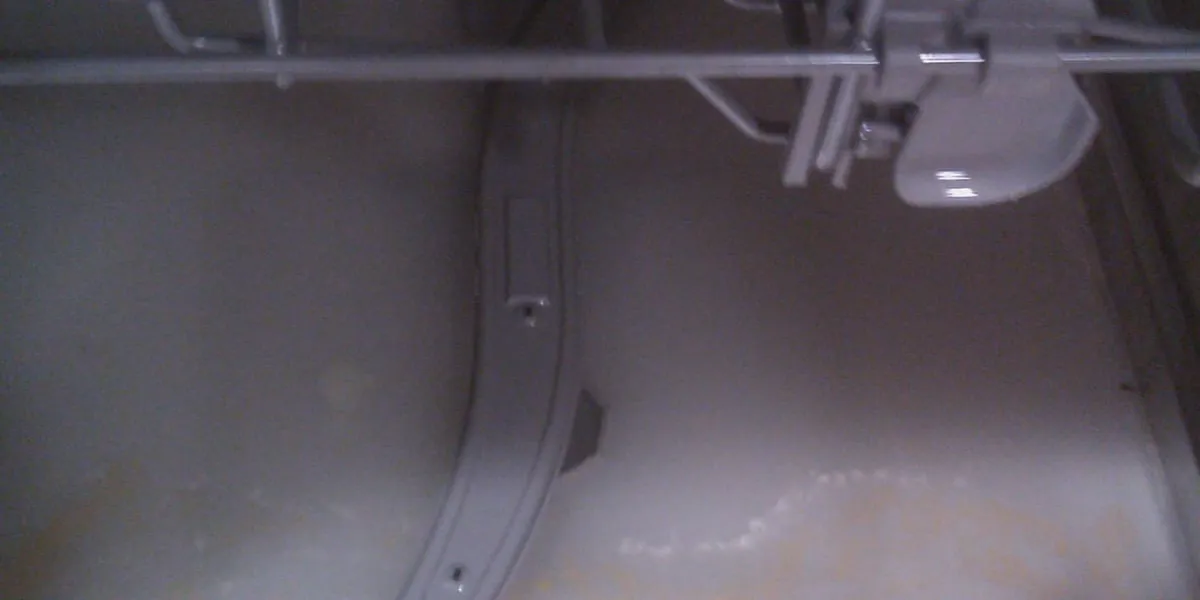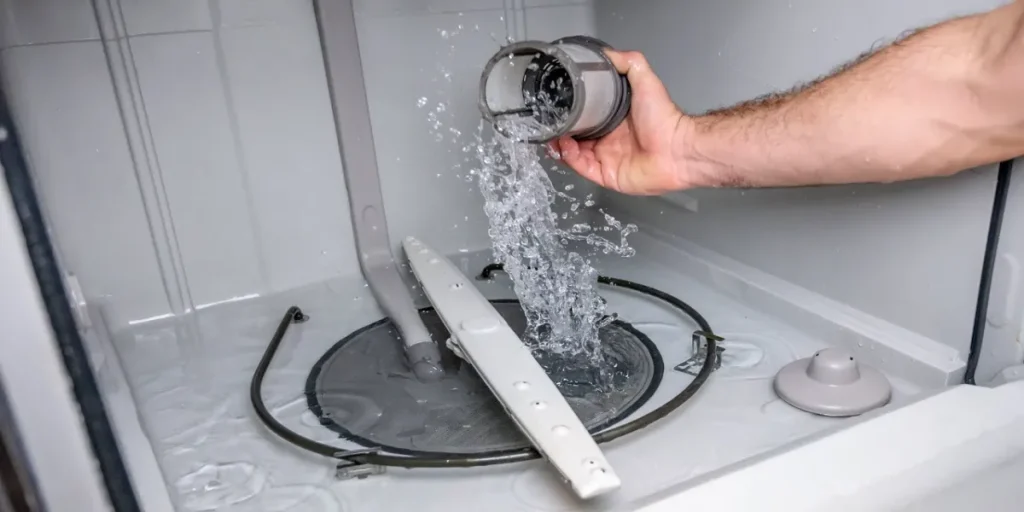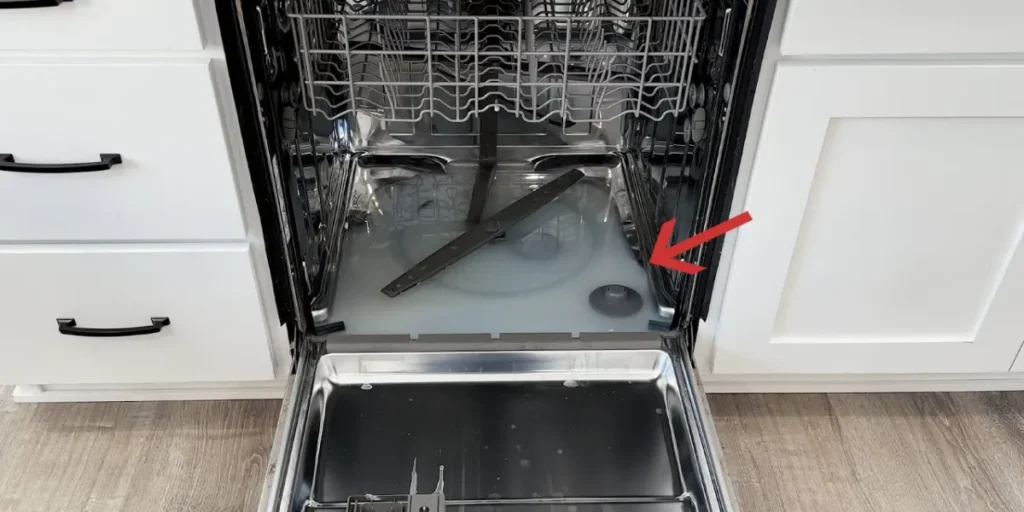Do you like how the Bosch dishwasher cleans your dishes and makes your life easier? But what if one day you find out that your dishwasher is filling up with water even when it’s not in use?
In this blog post, we are going to tell you everything you need to know about this common problem with Bosch dishwashers.
After reading this blog post, you’ll be an expert on Bosch dishwashers.

What Causes Your Bosch Dishwasher to Fill with Water?
There are many reasons why your Bosch dishwasher might fill up with water when it’s not in use. Some of them are:
Water Inlet Valve Malfunction
The water inlet valve is the part that lets water into your dishwasher when it needs to wash your dishes.
Often, this valve can get stuck or damaged, and it can let water in even when your dishwasher is off. This can cause your dishwasher to fill up with water and overflow.
Faulty Float Switch
The float switch is the part that tells your dishwasher when it has enough water inside. It’s a small device that floats on the water level and sends a signal to the control panel.
Sometimes, this switch can get dirty or broken, and it can send the wrong signal to the control panel.
This can cause your dishwasher to keep filling up with water even when it doesn’t need to.
Drainage Issues
The drainage system is the part that removes the dirty water from your dishwasher after it washes your dishes. It consists of a drain hose, a pump, and a filter.
Sometimes, this system can get clogged or blocked by food particles, grease, or other debris.
This can prevent the water from draining out of your dishwasher properly.
Damaged or Leaking Hoses
The hoses are the parts that connect your dishwasher to the water supply and the drain.
Sometimes, these hoses can get cracked, worn out, or loose. This can cause water to leak from them and fill up your dishwasher.
Software or Control Panel Errors
The software or control panel is the part that controls all the functions of your dishwasher. It tells your dishwasher when to start, stop, fill, drain, wash, rinse, dry, and so on.
Sometimes, this part can have glitches or errors that can affect how your dishwasher works.
This can cause your dishwasher to fill up with water randomly or not stop filling when it should.
Steps to Diagnose the Issue

Here are some steps you can follow:
Visual Inspection
The first thing you should do is visually inspect your dishwasher for any signs of damage or leakage. Look at the hoses, the valves, the switches, and the filters.
See if there are any cracks, holes, loose connections, or dirt on them. If you find anything suspicious, you might have found the cause of the problem.
Running Diagnostic Tests
The next thing you should do is run some diagnostic tests on your dishwasher. These are special programs that check if all the parts of your dishwasher are working properly.
You can find these programs in your user manual or online. To run a diagnostic test, you need to press some buttons on your control panel in a certain order.
The test will then start and show you some codes on the display. These codes will tell you if there are any errors or faults with your dishwasher.
Identifying Warning Signs or Error Codes
Another thing you should do is look for any warning signs or error codes on your display or indicator lights. These are signals that tell you if something is wrong with your dishwasher.
For example, if you see a flashing light or hear a beeping sound, it means there’s a problem.
You can also see some letters or numbers on the display that indicate what kind of problem it is. You can find out what these codes mean in your user manual or online.
Consulting the User Manual
The last thing you should do is consult the user manual of your Bosch dishwasher.
This is a booklet that comes with your dishwasher and tells you everything you need to know. It has instructions on how to use, maintain, and troubleshoot your dishwasher.
It also has diagrams and pictures that show you the parts and functions of your dishwasher. You can find the user manual in the box of your dishwasher or online.
How to Fix a Bosch Dishwasher That Fills with Water When Off?
Depending on the cause, you might need to replace or clean some parts of your dishwasher. Here are some ways you can fix the problem:
Water Inlet Valve Replace or Clean
If the water inlet valve is malfunctioning, you need to replace it or clean it. To replace it, you need to turn off the water supply and unplug the dishwasher.
Then, you need to remove the lower access panel and disconnect the wires and hoses from the valve. Next, you need to unscrew the valve from the bracket and install a new one.
Finally, you need to reconnect everything and test the dishwasher. To clean it, you need to follow the same steps until you remove the valve.
Then, you need to soak it in vinegar or use a brush to remove any dirt or debris from it. After that, you need to reinstall it and test the dishwasher.
Adjusting or Replacing the Float Switch
If the float switch is faulty, you need to adjust it or replace it. To adjust it, you need to open the dishwasher door and locate the float.
It’s a plastic dome-shaped device that moves up and down on a stem. You need to make sure that it’s not stuck or blocked by anything.
You can also try moving it up and down manually to see if it works. If it doesn’t, you need to replace it. You need to turn off the power and water supply and unplug the dishwasher.
Then, you need to remove the lower access panel and disconnect the wires from the switch.
Next, you need to unscrew the switch from the stem and install a new one. Finally, you need to reconnect everything and test the dishwasher.
Clearing Drainage Blockages
If there are drainage issues, you need to clear any blockages in the system. To do this, you need to turn off the power and water supply and unplug the dishwasher.
Then, you need to remove the filter from the bottom of the tub and clean it with water and soap. Next, you need to check the drain hose for any kinks or clogs.
You can use a wire hanger or a plumber’s snake to clear any obstructions. You can also detach the hose from both ends and flush it with water.
After that, you need to check the drain pump for any debris or damage. Remove the lower access panel and unscrew it from the base to gain access.
You can clean it with a cloth or replace it if needed. Finally, you need to reassemble everything and test the dishwasher.
Inspecting and Replacing Hoses
If there are damaged or leaking hoses, you need to inspect them and replace them if needed. To do this, you need to turn off the power and water supply and unplug the dishwasher.
You need to remove the lower access panel and check all the hoses for any cracks, holes, or loose connections. You can use a flashlight or a mirror to see better.
If you find any problems, you need to replace them with new ones. To replace them, you need to disconnect them from both ends and attach new ones in their place.
Make sure they are secure and tight. Finally, you need to test the dishwasher.
Resetting or Updating the Control Panel
If there are software or control panel errors, you need to reset or update them. To reset them, you need to press some buttons on your control panel in a certain order.
This will reboot your dishwasher and clear any errors or glitches. To update them, you need to connect your dishwasher to your Wi-Fi network and download any available updates from Bosch.
This will improve your dishwasher’s performance and fix any bugs.
Preventative Measures for Future

If you fix your Bosch dishwasher problem, you might want to prevent it from happening again. Here are a few tips for doing so:
Checks regularly
You should check your dishwasher regularly for any signs of wear and tear or damage.
You should also clean your dishwasher at least once a month with vinegar or a special cleaner.
This will help remove any grease, limescale, or bacteria that can cause problems.
Using Genuine Replacement Parts
You should always use genuine replacement parts for your Bosch dishwasher. These are parts that are made by Bosch and fit perfectly with your dishwasher.
They are also tested and certified for quality and safety. You can find genuine replacement parts online or by contacting Bosch Customer Support.
Keeping Software Updated
You should always keep your dishwasher’s software updated. This will ensure that your dishwasher has the latest features and functions.
It will also fix any bugs or errors that might affect your dishwasher’s performance. If any Bosch updates are available, you can download them using your Wi-Fi network.
Water Pressure Monitoring
You should also monitor your water pressure and connections regularly. You should make sure that your water pressure is not too high or too low for your dishwasher.
You should also make sure that your hoses and valves are not leaking or loose. You can use a water pressure gauge to measure your water pressure and a wrench to tighten your connections.
FAQs on Bosch Dishwasher Filling with Water When Not in Use
When I’m not using my dishwasher, does it fill with water?
Yes, a clogged or blocked drain hose can prevent your dishwasher from draining properly, causing it to fill with water.
What role does the float switch play in preventing this issue?
The float switch is a safety device that monitors the water level inside the dishwasher.
What causes the dishwasher to fill up with water unexpectedly?
While power surges or electrical issues can affect appliances, they are less likely to cause a dishwasher to fill with water.
Could this be a Bosch dishwasher issue?
This issue can occur with any dishwasher, not just Bosch models. It’s not specific to any particular brand or model.
Conclusion
If your Bosch dishwasher is filling with water when not in use, it’s a sign of a malfunction that requires immediate attention.
The issue could be a faulty inlet valve, a problem with the control board, or even plumbing issues. Ignoring it can lead to water damage and higher utility bills.
For a comprehensive diagnosis and repair, consult your user manual and hire a professional.
